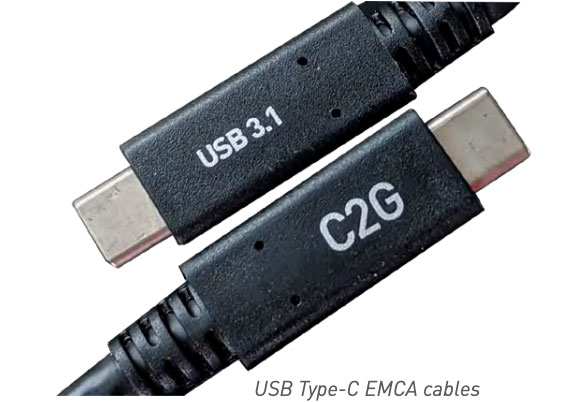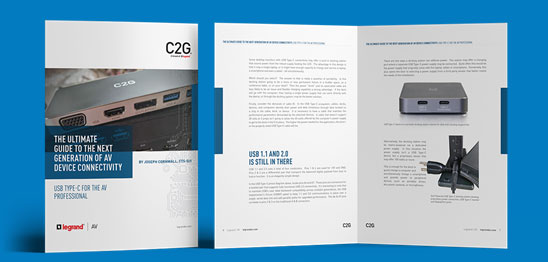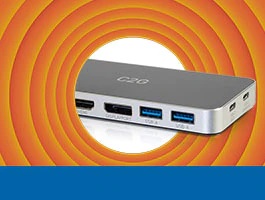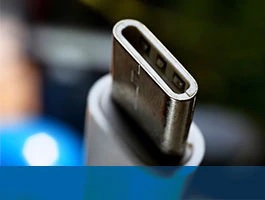EMCAS Passive and Active Cables
Posted on 10/26/2020 7:00:00 PM by C2G Team
You made it! Welcome to the final entry in our USB Type-C and Docking Stations series. To wrap this up, we’ll take a look at how cables communicate with devices about their capabilities.
An Electronically Marked Cable Assembly (EMCA) is a USB Type-C cable that uses a marker chip to communicate the cable’s characteristics to the attached devices. Inside these cables is an IC chip that processes the Power Delivery communication protocols. The electronic marking allows for role switching, alternate mode selection, and enhanced power options.

Depending on the design, a controller chip may be built into one or both ends of the cable. In all cases, the voltage rating of a cable is required to be higher than the “safe voltage” of 5V, so eMarkers aren’t required to assume that any given cable is 20V capable. However, all connections exceeding 3 amps of current (which can be up to 60 watts in the case of a 20V supply), or requiring transfer speeds greater than 480Mbit/S (USB 2.0), require an electronically marked cable.
One more time for clarity. A USB Type-C to Type-C cable doesn’t need a special e-marker to handle 20 volts, but it does need one to handle more than 3 amps of current or speeds beyond USB 2.0.
What does the cable communicate to the computer? There’s a lot of information shared in an EMCA relationship. Here is a partial list of what might be included in the transaction:
- The current rating of the cable - how much power it will transfer
- The length of the cable
- Passive or active cable design
- The type of connector at each end - Type-C to Type-C, Type-C to Type-A, etc.
- The number of cable controllers in the cable: single or dual
- The type of USB signaling: USB 2.0, USB 3.1 Gen 1, USB 3.1 Gen 2, etc
- The vendor ID, which is a 16-bit ID that identifies the EMCA manufacturer
- The product ID, which is a 16-bit ID that identifies the EMCA product
- The product’s ability to support Alternate Modes (e.g., DisplayPort, PCIe)
- Support for vendor-specific protocols (e.g., vendor-specific docking protocol)
Don’t confuse an EMCA with an active cable! EMCAs may be either passive or active.
All EMCAs carry all Type-C signals and are capable of running all USB 3.1 speeds. The distinction between active and passive status is associated with cable length. Like an HDMI cable, a USB Type-C cable has to deliver a clear eye pattern to the client. Maintaining a quality eye pattern becomes more challenging as the cable length grows, so active electronics are often added to create an active cable that will span a longer link than a passive cable without the active elements. The difference between an active and a passive EMCA is that the active cable offers signal conditioning of the SuperSpeed USB lanes, such as redriver or retimer functions, allowing the signal to traverse a greater distance.
DisplayPort, MHL, HMDI, and Thunderbolt may be supported via passive USB Type-C cables at transfer speeds up to 5Gbit/s (Superspeed) at lengths less than 2-meters, and up to 1-meter at 10Gbit/s (SuperSpeed+). For link lengths beyond 2-meters at 5Gbit/s, or 1-meter at 10Gbit/s, an active cable is required.

Want to learn more about docking stations, the unsung heroes of productivity installations? We have you covered. Get your white paper: The Ultimate Guide to the Next Generation of AV Device Connectivity.
Or take a look at some docks right now.
There's a Class For That
What’s Up, Dock?
What’s Up, Dock? Putting USB Type-C Docking Stations in Perspective

The challenge for future AV designers will be integrating mobile devices with fixed AV assets. Learn how docking stations solve the problem.
The Power of USB Type-C
C Into the Future: The Power of USB Type-C
Roughly every 20 years, a technology comes along that is so powerful it changes an entire industry. That technology is USB Type-C!



